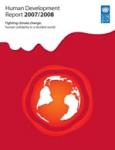Haiti, Development and Climate Change
 The United Nations Development Program (UNDP) has recently released its annual development report. The focus this year is on climate change. Two countries are frequently raised as cautionary tales thoughout the report - Bangladesh and Haiti.
The United Nations Development Program (UNDP) has recently released its annual development report. The focus this year is on climate change. Two countries are frequently raised as cautionary tales thoughout the report - Bangladesh and Haiti.
Bangladesh is not a country with a devastated environment. However, it is a country in which a great many live in coastal areas which are agriculturally productive, but prone to flooding - particularly when hit by hurricanes (cyclones) such as the recent Cyclone Sidr, which has caused extensive destruction and displaced many. Should the oceans rise and storms become frequent, it is not unthinkable that Bangladesh will be a major source of "climate displacement". In thise sense, Bangladesh's ability to meet the challenges of climate change is not just a national issue - it is also regional and international.
Rising oceans would likely result in increased flooding on its coastal towns such as Les Cayes. Port au Prince sprawls around a mountain, and the bidonvilles such as Cite Solei and Bel Air could certainly be affected. But Haiti's vulnerability to climate change comes directly from decade after decade of deforestation. It is difficult to see a preventive solution for Bangladesh, only ways of responding - improving early warning systems, training national forces to respond, moving major segments of the population a temporary or, if it came down to it, a permanent basis.
We may not be able to stop the storms, but we can certainly improve Haitian capacity to respond. The negative effects of erosion could be countered with strategic reforestation programs. As someone in a previous blog noted, if every person planted one tree a year it could make a difference. Now imagine if there were national reforestation campaigns that provided people with a livelihood while they worked to preserve the environment and reduce vulnerability to national disasters.
The reports notes that storms seldom cause as much damage to the Dominican Republic. The DR has set in place laws to limit deforestation, subsidizes propane, has a stronger infrastructure, and a civil defense force which is ten times larger than Haiti's for roughly the same land area.
To the government of Haiti, I would ask, no plead, that it be the first to take seriously the problem of deforestation in Hait. Show the donors you are serious. Pilot a clean and effective program in one part of the country - give it the resources, leadership, and personal oversight that it needs to succeed. it would make sense to start in the south, considering that flooding has become an annual event for them. If the program is strong, the resources to expand it will follow. Donors are not great at identifying innovative, new programs - but they can be useful at supporting them once they have been proven succesful.
On a scale of 177 countries, Haiti is ranked 146th. By way of comparison, Sudan is 147th. Reforestation will not solve all of Haiti's problems, but it is a needed and neglected piece of its development puzzle.
When we look at Haiti are we seeing the future? After 100 years more of climate change, will most of the world be like Haiti or will Haiti be the exception? We do hope that Haiti will have risen to the challenge and begun to preserve and protect its environment. To friends of Haiti, the status quo is not acceptable.
The (very large) report can be accessed by clicking here.
Welcome your thoughts.
Bryan
Add new comment